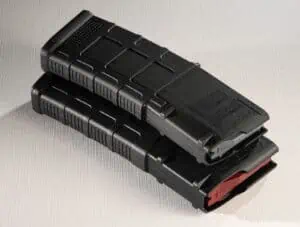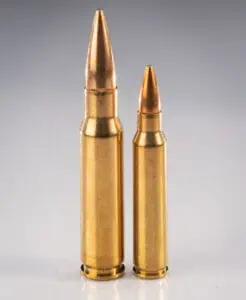Battle (Rifle) Royale: 223 vs 308
As the dust settled after World War II, the United States military had a problem. Their experience facing the new technology of the German Army demonstrated that the future of military rifles was a smaller gun with full auto capabilities, firing an intermediate cartridge. The issue was, the American service rifle at the time, the M1 Garand, was none of those things. Replacing the M1 Garand was just part of the problem. America’s NATO allies also saw the need for a new type of military rifle, and the race between 223 vs 308 began.
Fast Facts: 223 vs 308
- Both cartridges stem from the post-WWII downsizing of battle rifles
- 223 has been the standard U.S. cartridge for 50+ years, 308 less than a dozen years
- 308 is still in limited use with U.S. forces
The military conducted tests and trials to determine a better cartridge – the 30-06 or the .308. When the dust settled, the United States chose the .308 Winchester round as their standard military cartridge. The rest of NATO soon followed suit.
Meet The New Boss. Almost Like The Old Boss.
.308 Winchester (or 7.62x51mm as the military calls it) is based on the .300 Savage round. The typical bullet weight for this cartridge is something in the 150 to 180 grain range, and the round has the power to reach out to 800 yards and beyond.
However, the 308 cartridge was a bit of a compromise. The same power that gives 308 a nice healthy thump on the target and allows it to reach out to 1000 yards also makes it hard to control when fired full auto. The round is smaller and lighter than the .30-06 round it replaced in U.S. service, but other smaller and lighter calibers were available. A lighter round meant a soldier could carry more ammo in the battle. So, the search for a 308 replacement started only a few years after it became the standard NATO round.
A New Way Of Thinking About Military Rifles
The U.S. military eventually settled on a slightly modified version of 223 Remington, introducing it as the NATO 5.56x45mm cartridge. America’s allies eventually followed suit, and the round gained worldwide popularity. The changeover from 308 to 223 was not without some drama, however. Even now, 50 years after that change, the battle between supporters of 223 vs 308 rages on.
Which is kind of silly. Both rounds are well-suited to service in both the military and civilian worlds. Years of tweaking the 223/5.56mm round based on combat experience means the rounds of today work both in the field and defending our homes. The 308 round is still used by the military in many different applications, such as designated marksman rifles or in belt-fed, fully automatic machine guns.
Both rounds can be used to hunt game. 5.56mm does a great job harvesting hogs or hunting predators, and the 308 round can handle just about anything in North America that walks on four legs. 223 and 308 are both excellent for self-defense, and both are used extensively in competitions.
Can We Really Compare 223 vs 308?
Comparing 223 vs 308, then, is like comparing a station wagon to a minivan. They both have similar tasks, but they go about it in different ways. Station wagons and minivans are both designed to haul around 5 or more people. They can hold more goods than a typical four door sedan. They’re great family vehicles, and serve that purpose well.
However, in North America at least, the minivan has supplanted the station wagon. Are station wagons bad cars? No. I have many fond memories of long road trips in the back of my family’s 1978 Fairmont wagon, and I’m sure the children of today have similar memories about their parents’ minivan. Times change, however, and the advantages of a minivan (more volume, higher seating position, etc) meant the end of the line for the station wagon in the U.S. market.
Are there practical differences with 223 vs 308? Of course. When it comes to self defense, though, those differences are minimal. An exhaustive study by author and firearms trainer Greg Elllifritz showed that when it comes to stopping a gun fight, pistols are pistols, and rifles are rifles. But just how much power difference is there between 223 vs 308?
Testing 223 vs 308
To find out, we’re going to shoot two similar rounds from two similar guns. The ammo we’ll be using is PMC Bronze FMJ, 55 grain for 223 vs 308 using 147 grain ammo. We’ll shoot them from an AR-10 chambered in 308 with a 16 barrel, and we’ll shoot the 5.56mm rounds from an AR-15 with a 16 inch barrel. We’ll record the muzzle velocity from each round at the barrel and then plug those results into a ballistics calculator to get a sense of the performance of each round. Both rifles are sighted-in at 50 yards, and we’ll compare the bullet drop of each round at 500 yards to get an idea of their effective range.
55 Grain 223 FMJ Ammo
Average muzzle velocity – 2867 fps
Average muzzle energy – 1004 ft/lbs
Bullet drop at 500 yards – 75.02 inches
147 Grain 308 FMJ Ammo
Average muzzle velocity – 2672 fps
Average muzzle energy – 2330 ft/lbs
Bullet drop at 500 yards – 61.42 inches
There is obviously a huge difference in muzzle energy with 223 vs 308. This has led to a lot of discussion about “stopping power” and the effectiveness of both rounds in combat. 308 is the better choice for longer-ranged encounters, which is why it’s commonly used in designated marksman rifles. However, the 223 round has proven to be effective as the decades roll on. 223 may not be up to the task of dropping a moose in its tracks, but it is well-suited for defending home and homeland.
Purpose-Based Testing
The results are very similar when it comes to hunting rounds.
Fiocchi 165 Grain Interlock 308
Average muzzle velocity – 2746 fps
Average muzzle energy – 2762 ft/bs
Black Hills 60 Grain V-Max 223
Average muzzle velocity – 2911 fps
Average muzzle energy – 1129 ft/lbs
Federal 180 Grain Power-Shok 308
Average muzzle velocity – 2531 fps
Average muzzle energy – 2560 ft/lbs
Federal 64 Grain Soft Point 223
Average muzzle velocity – 2784 ft/lbs
Average muzzle energy – 1101 ft/lbs
The difference in muzzle energy is really noticeable here, with some the 308 caliber rounds delivering more than two and a half times more thump than their 223 equivalents. That sounds like a lot, and it is. You really don’t want to chase down anything bigger than an average-sized hog with a rifle chambered in 223. On the other hand, a miss with a 308 is just as effective (that is to say, not effective at all) as a miss with a 223 bullet. The time you spend on range honing your marksmanship will pay off in spades when it all comes down to one shot.
It’s How And Why You Shoot That Matters The Most
Ultimately, the choice of 223 vs 308 is about what tasks you need to perform with your rifle. 223 is a terrific choice for home defense and competition, and because it costs less per round than 308, it’s a great round for plinking or training. However, I chose 398 as the caliber for Scout Rifle 2.0, my “do it all” rifle because it offered me the best balance between all the potential reasons why I might need to use a rifle.
Noted gun writer Towsend Wheley once said that “only accurate rifles are interesting,” and over the years, both 223 and 308 have been proven to deliver outstanding accuracy. However, a rifle is only as accurate as the person behind the trigger. If you can’t with the target on-demand, a miss with a 308 round is just as useless (and a little more expensive) than a miss with a 223 bullet. Devote yourself to marksmanship, and the question of 223 vs 308 will answer itself.





